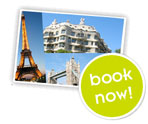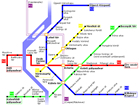Attractions
Buda Castle
While mentioning Buda Castle, we do not refer only to the Royal Palace, but to the entire medieval town crowning the Castle Hill. Strolling along the narrow and sinuous streets numerous restaurants are to be found, Gothic decorated doors and window frames, long gateways and charming squares are just as much features contributing to the medieval feeling. Part of the World Heritage Site (since 1987), several buildings in the Castle District are important in their own right, for example, Matthias Church, the Royal Palace (home to national collections and museums) and the office of the President of the Republic in the Sándor Palace, as well.
Royal Palace
This Baroque Palace was built in the 18th century and can be seen from almost every spot of Budapest.
The residence of Franz Joseph, Austrian Emperor and Hungarian King, and of the Habsburg archdukes, was created by the most outstanding Hungarian craftsmen at the turn of the 19th century.
The Palace suffered serious damage during the siege of the invading Turkish troops.
The current external appearance of the building complex is the result of Baroque-style building work in the 18th century, as well as remodelling and expansion in the 19th century.
The Palace was completely burnt out during World War II and the lavishly furnished stately halls were destroyed: the royal suites, the ballroom, and the throne room. The reconstruction took a simplified form; hence nowadays the Palace District is one of Budapest's most significant cultural centres. It is home to a comprehensive collection of Hungary's fine arts at the National Gallery (Nemzeti Galéria), exhibiting outstanding collections: the old Hungarian and the 19th-20th century paintings, sculptures, graphics, and contemporary collections, such as the works of Munkácsy Mihály, Mányoki Ádám, Szinyei Merse Pál, Csontváry Kosztka Tivadar./p>
The Budapest History Museum looks after the excavated architectural remnants of the old Royal Palace (13th century), amongst which are some fragments of statues from the Anjou era.
Eager for matchless views, tourists will be amazed while being carried up by the two step-structured carriages of the funicular railway (Budavári Sikló) from the bank of the Danube up to Buda Castle.
Matthias Church (Mátyás- templom)
This Roman Catholic Church consecrated to Our Lady (Nagyboldogasszony) is popularly known as Matthias Church; it was used for coronation ceremonies and royal weddings. Originally built in Gothic style, it was reconstructed several times - the neo-Gothic form we can see today was created at the turn of the 19th-20th centuries. The frescos and interior decoration date from this era and are the creations of the greatest artists of the time; Károly Lotz (1833-1904), Bertalan Székely (1833-1904), and Mihály Zichy(1825-1906).
King Béla III (reigned 1173-1196) and his wife, Anna of Antiochia, were laid to rest in a richly decorated sarcophagus in the church's Holy Trinity Chapel.
The church treasury and crypt are open to visitors. Due to its perfect acoustics, the church regularly hosts concerts.
Holy Trinity Column (Szentháromság-oszlop)
The Holy Trinity Statue, notable creation of the Baroque era (composition by Ungleich Fülöp and Hörger Antal), also lending its name to the square, is nearly 15 metres tall. Made of limestone, it is a hexagonal obelisk richly ornamented with statues.
The statues of the composition are between 1.8 and 2.8 metres tall. On the top of the column there is a group of statues representing the Holy Trinity, while its trunk is decorated with floating angels and clouds.
Three alternate sides of the hexagonal obelisk are particularly decorated. On these three sides of the pedestal there are relieves set in Baroque frames that depict King David pleading for the end of the plague, the plague (with the Castle of Buda in the background), and the construction of the Holy Trinity Memorial.
Fishermen's Bastion (Halászbástya)
The new Fishermen's Bastion designed by Frigyes Schulek was erected between 1895 and 1902 on the foundations of 18th century castle-walls to replace an old stronghold. The seven towers symbolize the seven leaders of the conquering Hungarian tribes.
The new Fishermen's Bastion, never served any defensive purposes.
In the middle of the Bastion's courtyard stands a statue of King St Stephen and, at the foot of the Bastion, a statue of János Hunyadi and a copy of the statue of St George in Cluj Napoca/Kolozsvár.
Rock Hospital (Sziklakórház)- A secret military underground hospital and bomb-proof shelter
The Rock Hospital is located under the Castle Hill inside the Buda Castle's cave-system.
The hospital was located 15-30 m from the ground on different levels. It was serving 200 people at the same time towards the end of 1943. Its length is approximately 2 km.
After the 2nd WW the hospital got reconstructed and it is now housing exhibitions of healing in Hungary from different ages: puppets show some scenes of the 18th century, from WW1 and WW2, also random scenes in hospital rooms where patients are healing, operation rooms, x-ray and also the kitchen of the hospital.
Museum of Military History (Hadtörténeti Múzeum)
The museum, awarded 'Museum of the Year' in 1999, is located in the building of the Nándor Barracks in the Buda Castle. Besides the armoury, the collection of uniforms, flags, numismatics are also significant. Apart of the permanent exhibitions hosted: 'Hand Weapons', 'The History of the Hungarian Defence Forces (Honvédség)', and 'The 13 Days of the 1956 Revolution', there is also a display of the siege of a medieval castle, almost 15 square metres in size.
Buda castle labyrinth (Budavári Labirintus)
The 1200 meters long cave-system is unique in its kind. Nowadays, it presents the different periods of Hungarian history in the exhibitions displayed in the caves, from the life of ancient people, the world of legends and beliefs to the Hun Empire, the age of Árpáds dynasty and the renaissance age of King Mátyás.
The speciality of this labyrinth is the path. One may choose different paths to follow: Ancient, Historic, The Other World or even the Labyrinth of Braveness, these can be revealed during the day. It is a unique delicacy to follow the night path of the labyrinth through the Lovers Labyrinth and Personal Labyrinth, as well as the Labyrinth of Lamps.
Víziváros St Anne's Church (Felso Vízivárosi Szent- Anna templom)
The twin-towered St Anne's Church, built between 1740 and 1758 , designed by Christoph and Michael Hamom and Matthäus Nepauer, is one of the most beautiful Baroque buildings in present-day Hungary. Before even completing the construction of the Jesuit church, several earthquakes followed by the dissolution of the order delayed the consecration of the church(1805).
The magnificent High Altar, portraying St Anne with her daughter Mary in the Temple of Jerusalem, dates from 1773 and is by Carlo Bebo, who also designed the pulpit. The side altars contain fine sculptures by Anton Eberhard and splendid paintings by the Viennese artist Franz Wagenschön.
Citadelle (Citadella)
Franz Joseph, The Austro-Hungarian Emperor and Hungarian King, had the stronghold built in 1851 (design by Emánuel Zita and Ferenc Kasselik) following the suppression of the 1848-49 War of Independence to keep the rebellious city under the control. Not less than sixty cannons were placed in this 220 metre-long, 60 metre-wide and 4 metre-tall fortress. After 1960 it was turned into a tourist centre, serving the city as a tourist attraction with beautiful views over the city and the Danube.
Statue of St Gerard (Szent Gellért-szobor)
The Statue of St Gerard is one of the ten statues donated by Franz Joseph, Emperor of Austria and King of Hungary. Nearly 7 metre high bronze statue looking across Pest from the side of Gellért Hill stands in the middle of a crescent-shaped arcade. The evangelist and bishop St Gerard is raising a cross towards the sky in his right hand while a Hungarian pagan warrior looks up at him from his feet (Gyula Jankovits was the sculptor of the Gerard figure, and Aladár Gárdos formed the pagan in 1904).
Contacts:
Hungarian National Gallery (Magyar Nemzeti Galéria)
Address: 1014 Budapest, I. district, Szentgyörgy tér 2.
Buda Palace, buildings B, C, D
Tel: 0036 20/4397308
Opening hours: Wednesday to Sunday: 10-18
Contact person: Szabó László
Entrance ticket: Only for temporary exhibitions; Permanent exhibitions can be visited free of charge.
Budapest History Museum (Budapesti Történeti Múzeum)
Address: 1014 Budapest, I. district, Szent- György tér 2.
Buda Palace, building E
Tel: 0036 1 3757533
Opening hours:
March 1st - May 15th Monday to Sunday (except Wednesday): 10-18
May 16th -September 15th :10-18
Matthias Church (Mátyás-templom)
Address: 1014 Budapest, I. district, Szentháromság tér 2.
Tel: 0036 1 3555657
Opening hours: Monday-Friday: 9-17, Saturday: 9-12, Sunday: 13-17 Contact: Pastoral office
Fishermen's Bastion (Halászbástya)
Address: 1014 Budapest, I. district, Vár (Castle)
March 15th- October 15th: 9-23: with entrance ticket, other hours — free of charge
Holy Trinity Column (Szentháromság- oszlop)
Address: 1014 Budapest, I. district, Szentháromság tér
Rock Hospital (Sziklakórház)
Address: 1012 Budapest, I. district, Lovas út 4/c.
Tel: 0036 30 6898775
E-mail: info@sziklakorhaz.eu
Opening hours: organized groups only (previous registration requested)
Contact: Pannónia Panoptikum Kulturális Kft Entrance tickets: student, senior citizen and family discounts available
Museum of Military History (Hadtörténeti Múzeum)
Address: 1014 Budapest, I. district, Tóth Árpád sétány 40.
Tel: 0036 1 3251600
E-mail: korsos.laszlo@hm-him.hu
Opening hours:April 1st-September 30th, Tuesday-Sunday: 10-18,
October 1st-March 31st, Tuesday-Sunday: 10-16
Contact person: Korsós László
Entrance ticket: Only for temporary exhibitions; Permanent exhibitions can be visited free of charge.
Buda castle labyrinth (Budavári Labirintus)
Address: 1014 Budapest, I. district, Úri u. 9.
Tel: 0036 1 4893281, 1 2120207, 1 2120287
Opening hours: Monday-Sunday: 9.30-19.30, 18-19.30, from 20.30
Víziváros St Anne's Church (Felso- vízivárosi (Szent- Anna) templom)
Address: 1011 Budapest, I. district, Batthyány tér 7.
Tel: 0036 1 2013404
Opening hours: Monday-Sunday: 6-18
Contact: Parrish office
Citadelle, Statue of St Gerard (Citadella, Szent Gellért szobor)
Address: 1013 Budapest, I. district, Gellért-hill(Gellérthegy)






